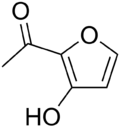
| |
| Names | |
|---|---|
|
Preferred IUPAC name
1-(3-Hydroxyfuran-2-yl)ethan-1-one | |
| Identifiers | |
3D model (
JSmol)
|
|
| ChemSpider | |
PubChem
CID
|
|
| UNII | |
CompTox Dashboard (
EPA)
|
|
| |
| |
| Properties | |
| C6H6O3 | |
| Molar mass | 126.11 |
| Melting point | 98 to 103 °C (208 to 217 °F; 371 to 376 K) |
| Insoluble | |
Except where otherwise noted, data are given for materials in their
standard state (at 25 °C [77 °F], 100 kPa).
| |
Isomaltol is a natural furan obtained by the enzymatic degradation of starch. It is also a flavor component in bread crust, produced by thermal degradation ( caramelization) of sugars. [2] Isomaltol is obtained after the Maillard reaction from an amino acid and a reducing sugar[ citation needed]
- ^ Merck Index, 11th Edition, 5066
- ^ Principles of Food Chemistry (1999), John M. DeMan, pg 286. ISBN 0-8342-1234-X